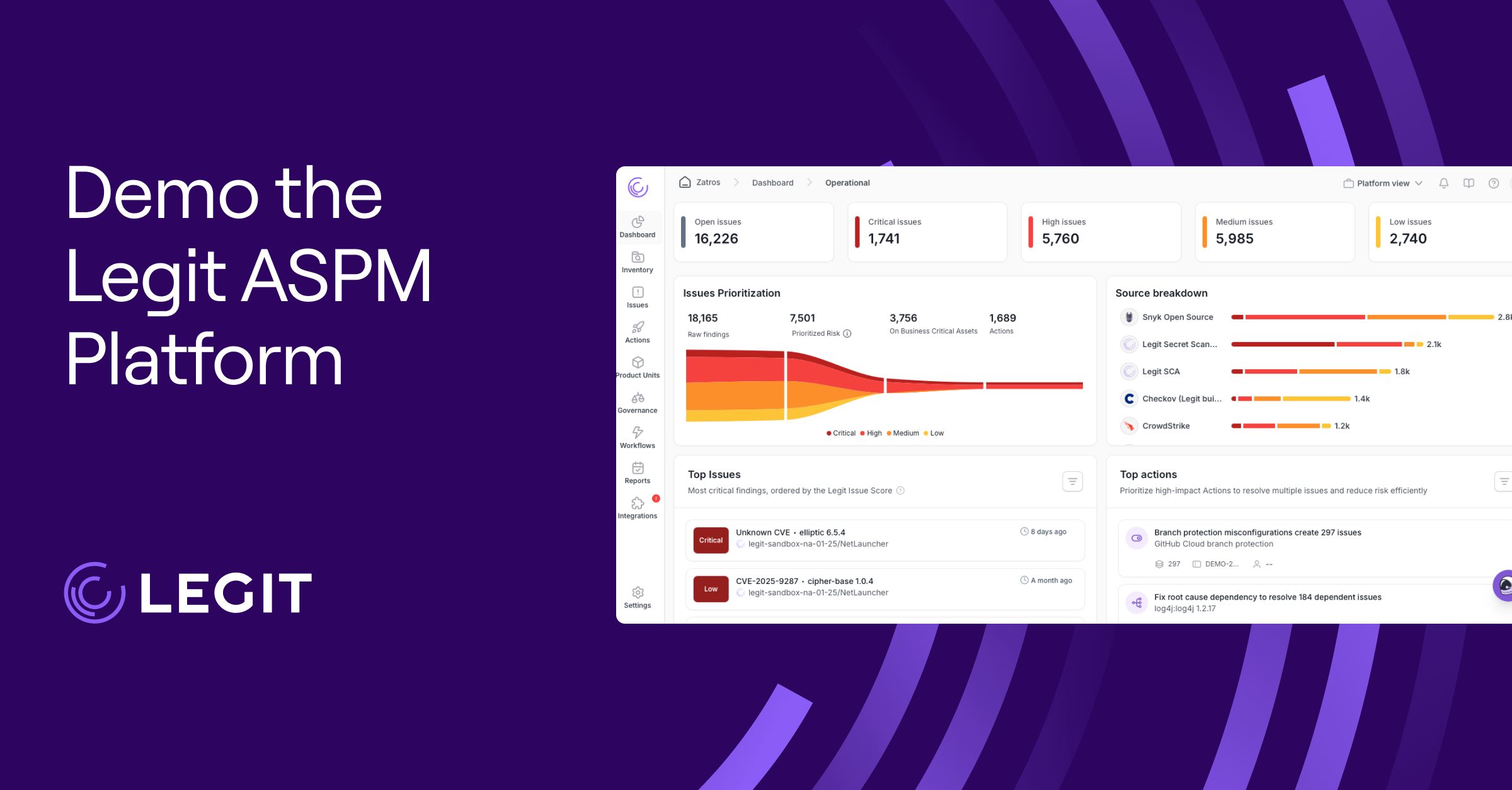Modern software development prioritizes speed and efficiency, and DevOps has played a significant role in streamlining the software development lifecycle (SDLC). It accelerates deployments and improves workflow efficiency by fostering collaboration between development and operations teams. But this focus on speed often leaves DevOps security as an afterthought, creating vulnerabilities attackers can exploit.
Here’s a breakdown of DevOps versus DevSecOps, why DevSecOps is the goal, and the steps for transitioning from DevOps to DevSecOps effectively.
What Is DevOps?
DevOps is a software development approach that integrates development and IT operations, streamlining workflows to improve collaboration and efficiency. DevOps accelerates software delivery while maintaining stability by combining automation, continuous integration and continuous delivery (CI/CD), and iterative feedback loops.
For example, in a DevOps pipeline, infrastructure provisioning—such as spinning up cloud instances or configuring servers—is automated using tools like Terraform or Ansible. This allows developers to deploy applications quickly without waiting for IT setup, reducing bottlenecks and improving operational efficiency.
DevOps’ main benefit is that it promotes shared responsibility between development and operations teams throughout the SDLC. But while this approach enhances agility, security gaps in DevOps workflows leave vulnerabilities undiscovered until late in development, increasing risk.
What Is DevSecOps?
Traditional security approaches can’t keep up with fast-paced SDLCs. DevSecOps—which stands for development, security, and operations—embeds security directly into every stage of development instead of treating it as an afterthought. By integrating security from the start, you can catch vulnerabilities early, reducing the risks, costs, and delays associated with last-minute security fixes.
DevSecOps extends DevOps by spreading security responsibilities across development, operations, and security teams. Adopting a shift-left strategy allows teams to integrate security into their workflows without slowing development. Scaling security alongside rapid software delivery also maintains applications' speed and resilience.
What Are the Similarities Between DevOps and DevSecOps?
While DevOps and DevSecOps have distinct goals, they share foundational principles that enhance software development. Both emphasize collaboration, automation, and continuous improvement to optimize workflows and increase reliability.
Below are four key areas where they overlap:
Automation
Automation is central to both DevOps and DevSecOps. Security automation tools help teams detect vulnerabilities early, reducing the risk of last-minute issues disrupting releases.
DevOps streamlines development, testing, and deployment, enabling teams to push updates quickly and reliably. DevSecOps extends this by directly embedding security automation—like vulnerability scanning, static code analysis, and compliance enforcement—into CI/CD pipelines.
Continuous Improvement
Both methodologies refine processes through feedback loops and monitoring. DevOps optimizes performance and deployment speed, while DevSecOps ensures security evolves alongside software changes. Modern security strategies, such as software composition analysis (SCA) and static application security testing (SAST), help teams manage risks proactively rather than responding to security gaps after deployment.
Collaboration
DevOps and DevSecOps both break down silos between teams to improve workflow efficiency. DevOps brings development and operations together, and DevSecOps expands this mindset by embedding security throughout the software development process.
Monitoring and Visibility
Both DevOps and DevSecOps depend on continuous monitoring. DevOps teams track system performance to detect failures early and DevSecOps integrates security monitoring throughout the SDLC. Expanding security visibility allows teams to stay ahead of evolving threats and scale security alongside development.
What Are the Differences Between DevOps and DevSecOps?
While DevOps and DevSecOps share a foundation of collaboration and automation, they diverge in their approach to security. DevOps prioritizes speed and operational efficiency and DevSecOps integrates security throughout development.
Below are the key differences between DevOps and DevSecOps:
Efficiency
DevOps accelerates software delivery by streamlining development and deployment, allowing teams to push updates quickly. But this speed can sometimes lead to overlooked security vulnerabilities. DevSecOps balances efficiency with security by embedding proactive security testing strategies and other protections, preventing security flaws without slowing development.
Security Integration Timing
In DevOps, application security is often considered a final step before deployment, leading to missed vulnerabilities. DevSecOps follows a shift-left approach, embedding security from the start. Security tests, compliance checks, and threat monitoring occur throughout the software development lifecycle, integrating security effectively.
Risk Management and Compliance
DevOps prioritizes software performance and deployment efficiency, but security isn’t always central. DevSecOps security instead takes a proactive approach.
But in practice, the distinction between DevOps and DevSecOps sometimes blurs. Many DevOps practices already incorporate security measures, and the level of security integration varies depending on the specific implementation.
Why Is DevSecOps the Goal?
DevSecOps isn’t an alternative to DevOps—it’s the next step in its evolution. As security threats grow more sophisticated, organizations can no longer afford to treat security as a separate phase. Making security part of your application early keeps it resilient, compliant, and scalable—without sacrificing speed.
Beyond security benefits, DevSecOps aligns with business goals by enhancing collaboration, reducing deployment risks, and ensuring regulatory compliance. While shifting left may require an initial investment in tools and training, it ultimately streamlines development by reducing late-stage security disruptions.
Transitioning from DevOps to DevSecOps: 6 Steps
Moving from DevOps to DevSecOps requires a deliberate approach that integrates security without disrupting development speed. The following steps create a smooth transition:
1. Assess Current Practices
Start by evaluating your current DevOps workflows to identify security gaps. Look at how security appears in CI/CD pipelines, access controls, and compliance measures.
2. Implement Automation Tools
Security automation is key to an effective DevSecOps strategy. Integrate tools like SAST, dynamic application security testing (DAST), and SCA to detect vulnerabilities early. Embedding these tools into CI/CD pipelines lets you catch issues in their early stages.
3. Understand Security Requirements
Every organization has unique security requirements based on industry standards and regulatory compliance. To enforce security policies throughout the SDLC, align development processes with frameworks such as the National Institute of Standards and Technology Cybersecurity Framework or ISO/IEC 27001.
4. Embed Security Into Development Workflows
Security must be a part of every software development phase. This means training developers in secure coding principles so security becomes a natural part of their workflow.
5. Foster a Security-First Culture
For DevSecOps to be effective, security must be a shared concern across all teams. This means fostering collaboration between development, security, and operations teams, making sure that security considerations are built into every stage of development.
6. Continuously Monitor and Improve
Security isn’t a one-time task. Implement continuous monitoring solutions to track security risks in real time. Regular security audits, threat intelligence, and feedback loops help organizations adapt to emerging threats and refine their security posture over time.
Strengthening DevOps and DevSecOps With Legit Security
DevSecOps isn’t separate from DevOps—it’s DevOps 2.0, embedding security throughout the development lifecycle. Both approaches streamline development, improve collaboration, and accelerate software delivery, but DevSecOps integrates security from the start rather than patching it in later.
Organizations shifting to DevSecOps gain automated security testing, early risk detection, and a security-first culture. And it starts with Legit Security.
Legit Security’s ASPM platform enhances this transition by embedding security into CI/CD pipelines without slowing teams down. It provides real-time visibility, enforces security policies, and ensures compliance, helping teams build secure, efficient software. Reach out for a demo and learn how Legit Security streamlines DevSecOps.
Download our new whitepaper.


